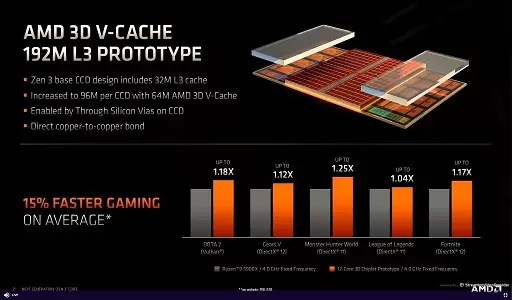The world’s first CPU equipped with 3D V-Cache was introduced to the market in 2022 by AMD with the debut of the Ryzen 7 5800X3D. It continues to be one of the most effective central processing units for gaming that can be purchased in 2023 and presents a formidable challenge to AMD’s Ryzen 7000 series and Intel’s Raptor Lake processors. However, it is no longer in the lead, as more recent Ryzen 7000-series 3D VCache CPUs are on the verge of offering even greater gaming performance.
Here is everything you need to know about 3D V-Cache while we wait to find out whether or not these brand-new 3D V-Cache chips are going to be the best processors.

What is AMD’s 3D V-Cache
The AMD 3D V-Cache technology is a packaging innovation that adds cache layers on top of a central processing unit (CPU). It may appear to be complicated, and from a technical point of view, it is, but it is not difficult to comprehend what AMD’s technology is accomplishing. AMD is stacking the cache on top of the processor, as opposed to the more conventional method of arranging the cache next to the processor. This allows more data to be stored on the chip.
It is a different approach to lay out a processor, and because of developments in how CPU makers put components on a chip, AMD is able to cram on more cache without building a gigantic CPU. The reason for this is because of the advancements in how CPU makers put components on a chip. Initially, the maximum number of cores that could be supported by the 3D V-Cache was limited to eight on the 5800X3D. However, with the Ryzen 7000 generation, AMD launched the eight-core 7800X3D, the 12-core 7900X3D, and the 16-core 7950X3D.
Having said that, this is not the complete picture. Even though those high-end CPUs have more than eight cores, the 3D V-Cache is only applied to one of the core complexes dies in each of those CPUs (CCD). In the case of the 7900X3D, it has six cores that have access to the 3D V-Cache and is clocked at a boost clock that is lower than the other CCD, which does not have the 3D V-Cache but is able to function at higher rates. The same is true for the 7950X3D, which possesses eight cores that are equipped with 3D V-Cache in addition to eight cores that operate at the higher boost frequency.
The goal is to provide a competitive edge in gaming while still making the high-speed cores available for use in activities that prioritize clock speed above cache requirements. At least according to the results of AMD’s first-party tests, this is one of the reasons why the company was able to achieve higher productivity performance with these CPUs in specific workloads.
It also claims to have worked extensively with Microsoft and game developers to ensure that the one-of-a-kind scheduling needs of such a CPU are met and catered for so that games and applications are able to make the most of these interesting CPUs. This was done in order to maximize the potential benefits that can be gained from using such CPUs.
How does the 3D V-Cache works?
The L3, also known as level 3 cache, is the most recent data that can be retrieved from your processor’s cache. Each cache level has a smaller footprint, but operates at a higher speed; together, they form a memory chain that connects to your processor and provides instructions when they are required.
Consider the cache to be similar to a supply chain. Your random access memory (RAM) is comparable to a large central storage facility, the L3 cache to a regional distribution center, and so on through the L2 and L1 caches. When we talk about additional L3 cache for 3D V-Cache, we are referring to the level that is the slowest on your CPU. However, despite this, each cache layer is still noticeably quicker than either your hard drive or RAM. This is merely a moderate level of sluggishness.
With a larger L3 cache, the processor is able to stream and store a greater number of instructions, reducing the frequency with which it must retrieve instructions from RAM. Although it performed poorly in some applications due to the limits imposed by the voltage and temperature thresholds of the 3D V-Cache, the 5800X3D was excellent for gaming despite having to operate at a slower clock speed. AMD believes it has found a solution to this issue with its Ryzen 7000 3D V-Cache central processing units, which provide high clock speeds on some cores while also providing V-Cache on the other cores.
What are the benefits of using 3D V-Cache?
Instead of increasing the amount of cache that is contained within the CPU itself, which has been the standard practice up to this point, AMD would rather develop a complete chip line that contains greater cache for a number of different reasons. To begin, 3D V-Cache can be configured in a greater variety of ways and is an optional add-on for processors that would truly profit from having it. There are many programs, including benchmarks like Cinebench R23, that do not benefit from having more cache. While additional cache does have its uses outside of gaming, there are also many apps that do not benefit from having an additional cache.
Cache presents additional challenges for the production of CPUs. The process or node, which dictates the performance, power efficiency, and transistor density characteristics of a CPU, is one of the most important parts of the manufacturing process. A cache is a component of a central processing unit that is significantly more difficult to shrink than other parts of the CPU, such as the cores. Newer nodes make it possible for transistors to be physically smaller, which results in more compact computers. Making a cache chip on an older and more affordable node can be more cost-effective due to the fact that the cache does not benefit from being located in cutting-edge nodes.
Which CPU has a 3D V-Cache?
The 5800X3D was initially introduced by AMD in the year 2022. This CPU is from the previous generation, Zen 3, and it has eight cores. Additionally, it has 96MB of L3 cache, which is made possible by the additional 64MB of 3D V-Cache. In addition to this, the new-generation 7800X3D, 7900X3D, and 7950X3D are now available to purchase.
| AMD Ryzen 9 7950X3D | AMD Ryzen 9 7900X3D | AMD Ryzen 7 7800X3D | AMD Ryzen 7 5800X3D | |
| Cores | 16 | 12 | 8 | 8 |
| Threads | 32 | 24 | 16 | 16 |
| L2 Cache | 16MB | 12MB | 8MB | 4MB |
| L3 Cache | 128MB | 128MB | 96MB | 96MB |
| Base clock | Up to 4.2GHz | Up to 4.4GHz | Up to 4.4GHz | Up to 3.4GHz |
| Boost clock | Up to 5.7Ghz | Up to 5.6GHz | Up to 5Ghz | Up to 4.5GHz |
| TDP | 120W | 120W | 120W | 105W |
Even though just fifty percent of the cores on each of the top two chips have the 3D V-Cache available, AMD has been able to include extra cores in this generation’s CPUs thanks to the 3D V-Cache. Since it only has six cores with 3D V-Cache accessible, the 7900X3D is an interesting CPU because it compares favorably to the 7800X3D and 7950X3D, both of which have eight cores each. It will be necessary to determine whether or not this fact makes the CPUs that bookend this generation the most advantageous for gaming.
The central processing units of this generation also run at greater clock speeds across the board; however, the highest frequencies will be reserved for the cores that do not have the 3D V-Cache. We do not yet know what frequencies they will run at when they are put into everyday usage, and it is possible that we will not know until we actually get our hands on the chips.
On the other hand, we are aware that AMD has made it possible to overclock to a certain degree with this generation, which was not the case with the 5800X3D. Although AMD has stated that it does not anticipate significant advantages from the use of these technologies, the company has enabled Precision Boost Overdrive (PBO) and AMD’s Curve Optimizer. Together, these features should allow enthusiasts to raise clock rates and lower voltages by a tiny margin.
Because the thermal design power (TDP) of each CPU is the same, this could indicate that there is more room for overclocking on cores that do not support 3D V-Cache and that these chips could end up being the most energy-efficient of their generation.
Performance of the 3D V-Cache
In our study of the Ryzen 7 5800X3D, we discovered that it was, on average, the fastest gaming central processing unit (CPU) that is currently available, edging out the Core i9-12900K by a hair. Since then, we’ve seen next-generation CPUs from AMD and Intel dethrone the 5800X3D, but despite being a generation behind and being several hundred dollars cheaper than the flagships, it’s still managed to remain competitive in the market.
Red Dead Redemption 2 is an intriguing example of an anomaly because it is the only game in which the 5800X3D is noticeably slower than both the 12900K and the 5950X. This was most likely not a mistake made while benchmarking, but rather a true loss brought on by the 5800X3D’s significantly lower clock speed. The 5800X3D can only boost up to 4.5GHz, but the 5950X can attain 4.9GHz. The frequency of the processor’s clock is still a crucial influence on gaming performance and can make a substantial impact in some games. It will be fascinating to observe if the problem has been fixed in the Ryzen 7000 3D V-Cache CPUs thanks to their newly designed architecture.
Because preliminary indications suggest that the new central processing units (CPUs) are up to 25% faster than Intel’s 13900K, we are excited to see what these CPUs are capable of doing.
A paradigm shift in packaging?
When AMD introduced its 3D V-Cache, the company made a huge deal out of it, and for good reason. Even with its rumored 6GHz 13900KS waiting in the wings, the 5800X3D was able to hold its own against considerably more powerful CPUs, and the next-generation Ryzen 7000 versions look primed to capture the gaming title from Intel.
It is not yet obvious whether this is a technology that will benefit everyone and deserves to be included in the more mainstream CPU lines; nonetheless, it is clear that gaming experiences a significant boost. Even though the 3D V-Cache technology is a great mid-generation refresh for AMD processors and helps the company stay one step ahead of the competition, it does not exactly encourage gamers to be early adopters of new AMD hardware. This is because the technology also works as a great mid-generation refresh for Intel processors.
If the graphs provided by AMD are to be believed, 3D V-Cache is more than just marketing hype, it even has the ability to boost the performance of some tasks that are not related to gaming. We won’t know for sure how good the new hardware is until we put it through our own testing, but if the 5800X3D is any indication, the 3D V-Cache technology is still something to get extremely excited about.
Would you like to read more about AMD 3D V-Cache-related articles? If so, we invite you to take a look at our other tech topics before you leave!










